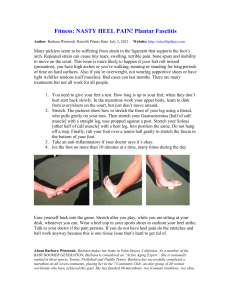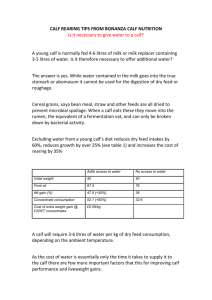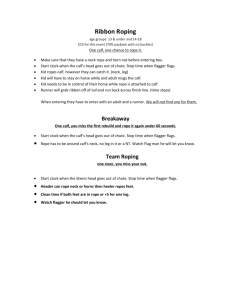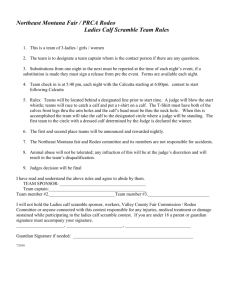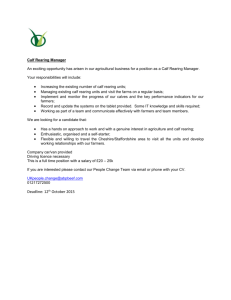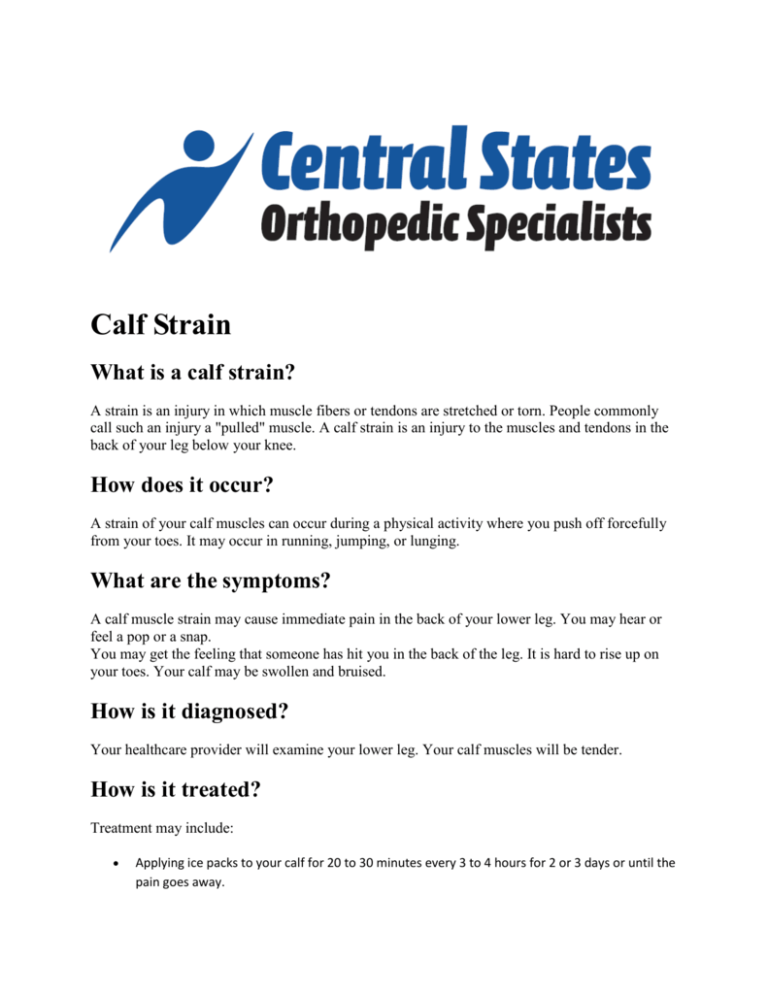
Calf Strain
What is a calf strain?
A strain is an injury in which muscle fibers or tendons are stretched or torn. People commonly
call such an injury a "pulled" muscle. A calf strain is an injury to the muscles and tendons in the
back of your leg below your knee.
How does it occur?
A strain of your calf muscles can occur during a physical activity where you push off forcefully
from your toes. It may occur in running, jumping, or lunging.
What are the symptoms?
A calf muscle strain may cause immediate pain in the back of your lower leg. You may hear or
feel a pop or a snap.
You may get the feeling that someone has hit you in the back of the leg. It is hard to rise up on
your toes. Your calf may be swollen and bruised.
How is it diagnosed?
Your healthcare provider will examine your lower leg. Your calf muscles will be tender.
How is it treated?
Treatment may include:
Applying ice packs to your calf for 20 to 30 minutes every 3 to 4 hours for 2 or 3 days or until the
pain goes away.
Elevating your leg on a pillow while you are lying down.
Wrapping an elastic bandage around your calf to keep the swelling from getting worse.
Using crutches, if it is too painful to walk.
Taking anti-inflammatory medicine. Adults aged 65 years and older should not take nonsteroidal anti-inflammatory medicine for more than 7 days without their healthcare provider's
approval.
Getting physical therapy, which may include treatment of the muscle tissue by a therapist using
ultrasound or muscle stimulation.
Having your healthcare provider or therapist tape the injured muscles while they are healing to
help you to return to athletic activities.
Doing rehabilitation exercises.
While you are recovering from your injury, you will need to change your sport or activity to one
that does not make your condition worse. For example, you may need to swim instead of run.
How long will the effects last?
The length of recovery depends on many factors such as your age, health, and if you have had a
previous calf injury. Recovery time also depends on the severity of the injury. A mild calf strain
may recover within a few weeks, whereas a severe injury may take 6 weeks or longer to recover.
You need to stop doing the activities that cause pain until the muscle has healed. If you continue
doing activities that cause pain, your symptoms will return and it will take longer to recover.
When can I return to my normal activities?
Everyone recovers from an injury at a different rate. Return to your activities will be determined
by how soon your calf recovers, not by how many days or weeks it has been since your injury
has occurred. In general, the longer you have symptoms before you start treatment, the longer it
will take to get better. The goal of rehabilitation is to return you to your normal activities as soon
as is safely possible. If you return too soon you may worsen your injury.
You may safely return to your activities when, starting from the top of the list and progressing to
the end, each of the following is true:
You have full range of motion in the injured leg compared to the uninjured leg.
You have full strength of the injured leg compared to the uninjured leg.
You can walk straight ahead without pain or limping.
How can calf strains be prevented?
Calf strains are best prevented by warming up properly and doing calf-stretching exercises
before your activity. This is especially important if you are doing jumping or sprinting sports.
Written by Pierre Rouzier, MD for RelayHealth.
Calf Strain Rehabilitation Exercises
You can begin gently stretching your calf muscle using the towel stretch right away. Make sure
you only get a gentle pull and not a sharp pain while you are doing this stretch.
Towel stretch: Sit on a hard surface with one leg stretched out in front of you. Loop a towel
around your toes and the ball of your foot and pull the towel toward your body keeping your
knee straight. Hold this position for 15 to 30 seconds then relax. Repeat 3 times.
After you can do the towel stretch easily, you can start the standing calf stretch.
Standing calf stretch: Facing a wall, put your hands against the wall at about eye level. Keep one
leg back with the heel on the floor, and the other leg forward. Turn your back foot slightly
inward (as if you were pigeon-toed) as you slowly lean into the wall until you feel a stretch in the
back of your calf. Hold for 15 to 30 seconds. Repeat 3 times and then switch the position of your
legs and repeat the exercise 3 times. Do this exercise several times each day.
After a couple days of stretching, you can begin strengthening your calf and lower leg muscles
using elastic tubing as described in the next exercise.
Resisted ankle plantar flexion: Sit with your leg outstretched and loop the middle section of the
tubing around the ball of your foot. Hold the ends of the tubing in both hands. Gently press the
ball of your foot down and point your toes, stretching the tubing. Return to the starting position.
Do 3 sets of 10.
You may do the last 4 exercises when you can stand on your toes without pain.
Heel raise: Balance yourself while standing behind a chair or counter. Using the chair to help
you, raise your body up onto your toes and hold for 5 seconds. Then slowly lower yourself down
without holding onto the chair. Hold onto the chair or counter if you need to. When this
exercise becomes less painful, try lowering on one leg only. Repeat 10 times. Do 3 sets of 10.
You can challenge yourself by standing only on your injured leg and lifting your heel off
the ground.
Single leg balance: Stand without any support and attempt to balance on one leg. Begin with
your eyes open and then try to perform the exercise with your eyes closed. Hold the single-leg
position for 30 seconds. Repeat 3 times. When you have mastered this, try doing this exercise
standing on a pillow.
Nose touch: Stand on one leg facing a wall. Stand 4 inches from the wall. Keep your body and
leg straight. Slowly lean forward, trying to touch your nose to the wall. Make sure you do not
bend forward at your waist. Do 3 sets or 10.
Wall jump: Face a wall and place a piece of masking tape about 2 feet above your head. Jump
up with your arms above your head and try to touch the piece of tape. Make sure you do a
"spring" type of motion and do not land hard onto your feet. Progress to taking off and landing
on one foot. Do 3 sets of 10.
Another good exercise is hopping. You can start at one end of the room and try to hop as
high as you can across the room on one foot. Jumping rope is also a good exercise.
Written by Tammy White, MS, PT, and Phyllis Clapis, PT, DHSc, OCS, for RelayHealth.
Published by RelayHealth.
Last modified: 2009-02-08
Last reviewed: 2007-07-20
This content is reviewed periodically and is subject to change as new health information becomes
available. The information is intended to inform and educate and is not a replacement for medical
evaluation, advice, diagnosis or treatment by a healthcare professional.
Sports Medicine Advisor 2009.1 Index
Sports Medicine Advisor 2009.1 Credits
© 2009 RelayHealth and/or its affiliates. All Rights Reserved.


